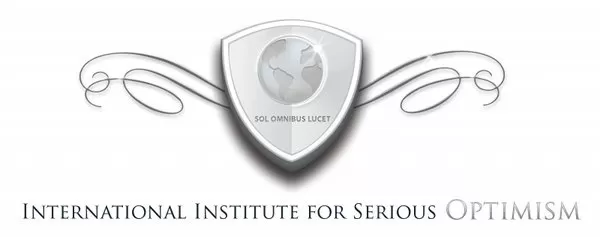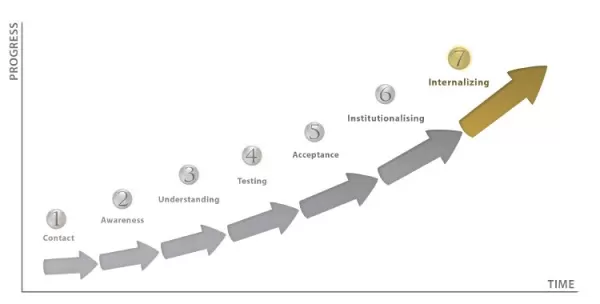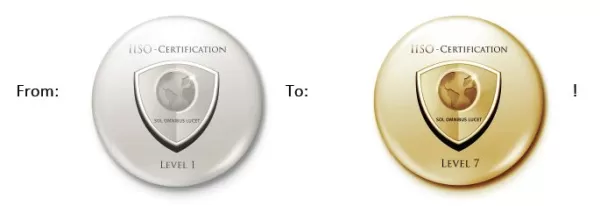Certification Approach

Aim of the certification process is to assess the maturity of the development of an O-zone: An environment in which Serious Optimism is directly related to Performance. We use some concepts that enable us to characterize an O-zone:
A. The O-zone is divided into the following four sub-environments:
I. Process/Organization: the systems, procedures, organization scheme, etc.
II. Culture/Behavior: the norms, values, backgrounds, communication, diversity, etc. within an organization
III. Virtual/Digital: websites, social media, mobile communication, apps, etc.
IV. Real/Physical: properties of the physical environment, like colors, shapes, natural aspects, sounds, materials, etc.
B. To assess the amount of positive energy, we use the criteria that lead to enthusiasm:
1. Relief: unexpected help, getting rid of tasks, getting rid of responsibilities, decision support, saving time
2. Flexibility: spontaneous reaction, adaptiveness, differing from standards, caring for individual needs
3. Generosity: excess, lavish, more than the necessary
4. Prudence: thinking outside the box, being one step ahead, consideration of circumstances
5. Success: pride, reached aims, affirmation
6. Completion: beauty, virtuosity, perfection, ‘the divine’
7. Exclusiveness: rareness, limitation, luxury
8. Sense of belonging: interaction, synergistic effect, being a part, feeling supported
9. Authenticity: sincerity, honesty, transparency, confidence
C. Furthermore, we look at creativity as driver for new value creation.
For creativity, we use the creativity index:
C = Q x L, in which C is the creativity index, that is obtained by multiplying the frequency of Questions Q with the frequency of Laughs L. The first relates to the openness and curiosity in an environment, the second to humor as indicator for new, unexpected connections and ability to allow for the (seemingly) impossible.
D. Maturity/certification Levels:
Introduction and implementation of Serious Optimism requires change. Therefore, we relate the various levels of Serious Optimism to the stages in a change management process (see figure).

So, an organization can achieve 7 O-levels. To assess the O-zone level, all relevant stakeholders should be approached and answer the following questions (with supporting evidence/examples). In describing the (planned) interventions, the 4 different subspaces should be addressed.
These are:
O-Level 1 (Contact):
- Has the organization questions/concerns about performance?
- Is the organization interested in exploring ways to improve the level of Serious Optimism?
O-Level 2 (Awareness):
- Does the organization have an idea about the relevance Serious Optimism?
- Is the organization able to link Serious Optimism to Performance?
O-Level 3 (Understanding):
- Does the organization have an idea about the various components (subspaces) of an O-zone?
- Is the C-factor accepted as relevant property of O-zones?
- Is the organization capable/willing to do some experiments with Serious Optimism?
- Does the organization know how it wants to start?
- Does the organization know the necessary effort/resources to make the start?
- Does the organization know how to assess the success/impact?
O-Level 4 (Testing):
- Has the organization experience with interventions/prototyping to increase the O-Level?
- What subspaces are addressed in the test phase?
- How has the C-factor been addressed in the experiments?
- Has the organization plans/experience to assess the impact of interventions, linking Serious Optimism to Performance
O-Level 5 (Acceptance):
- Is there evidence that the amount of positive energy has increased?
- On a scale from 0-1, what is the perceived value of the Q and L-factors (the product is the C-factor)?
- Is there evidence that performance goals have been achieved?
- Is there evidence that these two are related to each other?
- Is the organization open for new tests and/or further increasing the O-Level (level )?
O-Level 6 (Institutionalization):
- Are there best practices that are being used?
- Are all (relevant) subspaces addressed and are they linked to each other in the right way?
- Is the C-factor part of the strategy?
- Is there a feedback/learning system for Serious Optimism in place?
- Are there ways to scale-up/further develop/structurally apply serious optimism related practices?
O-Level 7 (Internalization):
- Is there an embedded relation between Serious Optimism and performance?
- Is Serious Optimism focus within continuous improvement?
- Is the organization internally and externally being recognized as an authority in the area of Serious Optimism?

Organizations that are interested in the Serious Optimism certification, can contact the International Institute for Serious Optimism via the website: www.iiso.eu or via the contact persons in The Netherlands (Paul Iske: paul@iiso.eu) or Norway (Tom Age Myhren: tom@iiso.eu).
In a personal intake, we will advise you on the Certification Process, possibilities to increase the O-Level as well as ways how to exploit your achievements in the area of Serious Optimism.

